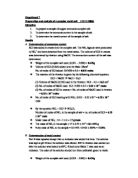The uses of Ammonia, Nitric Acid and Sulphuric Acid
in the manufacture of inorganic fertilisers
Why are they required, are there any problems with their use,
e.g pollution, if so, how are they overcome?
By Laura Bateman
Fertilisers are compounds given to plants to promote growth, they are usually applied either through the soil for uptake by plant roots, or by foliar feeding for uptake through leaves. Fertilizers can be organic (composed of organic matter), or inorganic (made of simple, inorganic chemicals or minerals). They can be naturally occurring compounds such as peat or mineral deposits, or manufactured through natural processes (such as composting) or chemical processes (such as the Haber process). They typically provide, in varying proportions, the three major plant nutrients- nitrogen, phosphorus, Potassium (N-P-K), the secondary plant nutrients- calcium, sulphur, magnesium (Ca-S-Mg) and sometimes trace elements or micronutrients with a role in plant nutrition (Boron-B, Chlorine-Cl, Manganese-Mn, Iron-Fe, Zinc-Zn, Copper-Cu and Molybdenum-Mo). Both organic and inorganic fertilisers are called manures, derived from the French expression for manual tillage, but this term is now mostly restricted to organic manure.





![The purpose of this experiment is to study the effect of an oxidizing acid [concentrated sulphuric(VI) acid] and a non-oxidizing acid [ concentrated phosphoric(V) acid] on three solid potassium halides, namely potassium chloride, potassium bromide and pot](https://mbt-essays-prod-public.s3.eu-west-1.amazonaws.com/910451/listing/910451_1.jpg)


